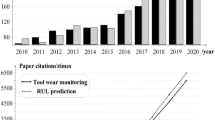Abstract
Accounting for the increase of wear in metal forming tools, it is eminent to have detailed information about the tool lifetime already during the tool design. With the wear simulation tool REDSY—developed at the Institute of Metal Forming and Casting—tool wear can be simulated qualitatively and quantitatively for sheet metal forming processes. The calculations are based on Archard’s wear model, a model using contact mechanics to describe the wear behavior. In this project, a new approach to determine the wear coefficient has been developed using a simple cylindrical cup deep drawing experiment for the wear measurements. Several tool and sheet material combinations were analyzed using a five-stage progressive die tool in a precision automatic punching press in order to achieve a high wear volume in a short period of time. The wear coefficient for the respective material combination could be determined combining the experimental results with simulation. This method is verified by comparing the wear simulation results with actual measurements.









Similar content being viewed by others
References
Archard JF (1953) Contact and rubbing of flat surfaces. J Appl Phys 24:981–988
Hwang C, Hoffmann H (2003) Einsatz numerischer Methoden zur Verschleißbewertung von Werkzeugen der Blechumformung, EFB Forschungsbericht, EFB/AiF Forschungsvorhaben 12646N
Hwang C, Golle R, Hoffmann H (2002) Numerical method to estimate the wear of a tool in sheet metal forming. Numisheet 67–72
Hoffmann H, Hwang C, Ersoy K (2005) Advanced wear simulation in sheet metal forming. CIRP Ann 54(1):217–220
Ersoy K, Nuernberg G, Herrmann G, Hoffmann H (2006) Wear simulation of deep drawing tools with Abaqus/explicit. In: Proceedings 18. Abaqus Benutzerkonferenz Erfurt, part 2.7
Nuernberg G, Ersoy K, Herrmann G, Hoffmann H (2006) Prediction of wear in deep drawing tools using REDSY and Pamstamp 2G. In: Proceedings of EuroPAM 2006
Ersoy K, Herrmann G, Nuernberg G, Golle, M (2006) Enhancing the wear simulation of sheet metal forming process with variable wear coefficients. In: Proceedings of iddrg pp. 635–642
Staeves J (1998) Beurteilung der Topographie von Blechen im Hinblick auf die Reibung bei der Umformung, Dissertation, Technische Universität Darmstadt
Van der Heide E, Burlat M, Bolt PJ, Schipper DJ (2003) Wear of soft tool materials in sliding contact with zinc-coated steel sheet. J Mater Process Technol 141:197–201
Groche P, Henning R, Filzek J. Eine neue Prüfmethode für das Abriebverhalten verzinkter Tiefziehbleche, UTFscience I/2004
Author information
Authors and Affiliations
Corresponding author
Additional information
This project was funded by Germany’s Bundesministerium für Wirtschaft und Arbeit (BMWA) over Arbeitsgemeinschaft industrieller Forschungsvereinigungen “Otto von Guericke” e.V. (AiF). Project code: AiF14291N.
Rights and permissions
About this article
Cite this article
Hoffmann, H., Nürnberg, G., Ersoy-Nürnberg, K. et al. A new approach to determine the wear coefficient for wear prediction of sheet metal forming tools. Prod. Eng. Res. Devel. 1, 357–363 (2007). https://doi.org/10.1007/s11740-007-0065-1
Received:
Accepted:
Published:
Issue Date:
DOI: https://doi.org/10.1007/s11740-007-0065-1




